- NGOs and companies across Cambodia are taking action in response to the mass use of charcoal and forest biomass in household and restaurant kitchens countrywide. The shift away from these polluting fuel sources to cleaner energy alternatives is being sparked by health and environmental concerns.
- Education is a key strategy for implementing the shift away from charcoal and wood, as their use is ingrained in the culture, with many Cambodians saying food doesn’t taste as good when cooked with other fuels.
- One innovative solution is turning the country’s coconut husks into “green charcoal,” which is already earning the nation recognition for being a global leader within the sustainable charcoal sector.
- Cambodia’s farmers are also moving away from using forest biomass for energy, and are instead utilizing biodigesters to turn household and farm waste into biogas for cooking and to make organic fertilizer.
Sim Saran spent years navigating the badly ventilated traditional kitchen of her small family home in Cambodia’s Siem Reap province. Choking on acrid smoke daily, she found it hard to breathe as she cooked for her family of six over a wood fire, just as past generations had done. “I know it’s smoky, but I had no choice,” the 20-year-old said.
Sim’s family was just one of 2.5 million Cambodian families who use traditional cookstoves fueled by forest biomass — mostly charcoal and wood — impacting their health, causing deforestation and contributing to climate change.
But that is fast changing, as Sim and her community learn about cleaner cooking methods that are good for people, forests and the planet.
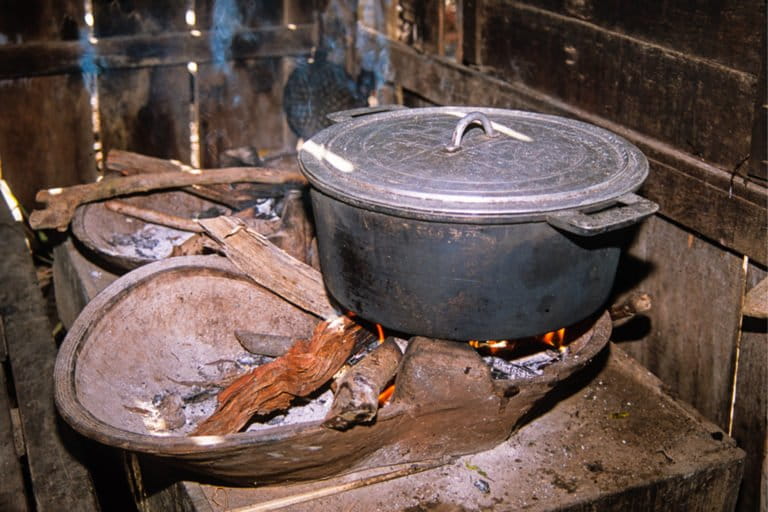
An ingrained woodburning tradition
The Clean Cooking Alliance, an NGO, reports that biomass burning accounts for 74% of energy use by Cambodians, with 80% of that biomass used for cooking. That’s mostly because just 32% of Cambodians have access to a clean cooking stove, according to the World Bank.
That deficit is now spurring major nationwide efforts to clean up Cambodia’s kitchens.
“This has huge consequences for livelihoods and the environment,” said Bastiaan Teune, global clean cooking coordinator for SNV, a Dutch development organization, in Cambodia. The NGO has been promoting safe, clean cooking methods there since 2015.
SNV’s work is likely already saving both lives and trees. About 14,000 Cambodians die annually due to household air pollution, according to the World Health Organization (WHO). In comparison, 15,000 die from smoking tobacco. The WHO warns that inhaling tiny soot particles during cooking with wood and charcoal can cause respiratory, pulmonary and cardiovascular disease and lung cancer. Women and children are most at risk.
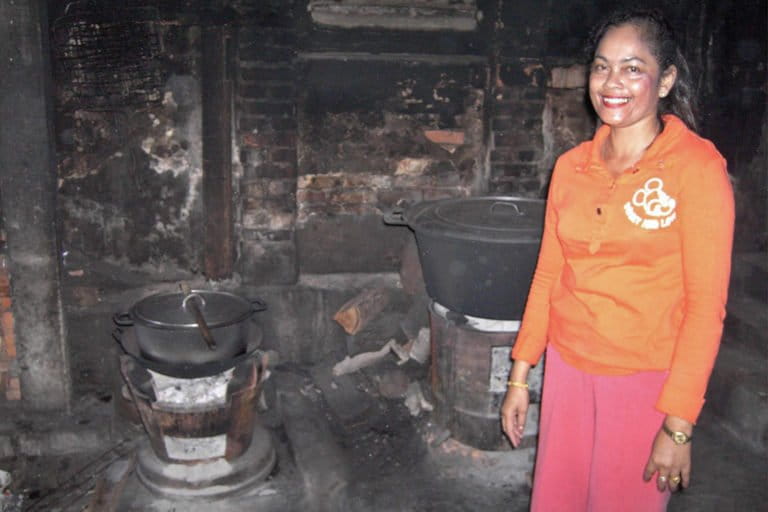
“It’s mainly women and children who take care of the cooking,” Teune explained. “We see that especially children take care of the stove when smoke is at its worst, ignited with plastic, rubber or twigs that release chemicals and harmful particles. With children in particular, pneumonia is an issue, and [with that disease] there is a very strong correlation with air quality.”
The near-universal use of wood stoves is also an issue in a country where deforestation rates are among the world’s fastest. Between 2002 and 2020, Cambodia lost 1.28 million hectares (3.1 million acres) of primary humid tropical forest, according to Global Forest Watch.
While this tree loss is due predominately to illegal deforestation and large-scale agriculture, the use of forest biomass for cooking also takes its toll. In the capital city Phnom Penh alone, for example, more than 100,000 tons of charcoal is used annually — the equivalent of 1 million tons of wood. The city mainly sources its charcoal from large-scale producers based at Phnom Aural within the Phnom Aural Wildlife Sanctuary, a protected area.
Traditional wood and charcoal cookstoves, like the Lao stove that the 85 households in Sim’s commune use twice daily, also contribute to climate change.
“The total emissions from cooking with biomass globally are the same as the global aviation industry,” Teune said. “So, when you’re concerned about big jumbo jets, the accumulated emissions are equal to all those small wood and charcoal fires people use for cooking.”

Seeking a community-wide solution through education
In 2015, SNV rolled out a program to introduce cleaner stoves across Cambodia. It partnered with the private sector to offer financial incentives to encourage rural communities to trade in their traditional stoves for modern cooking alternatives including gas stoves or clean charcoal.
But the program was hampered early on by a lack of education, affordability, and the inability to quickly scale up stove changeover.
“To reduce the health risks, you can’t [just] sell one stove per street, you need a whole street or village. Otherwise the smoke will arrive from your neighbor,” Teune said. “You need a collective movement where cooking patterns change. We realized from experiences in our water and sanitation programs that [communitywide] education and change in behavior is key.”
In mid-2020, SNV shifted its tactics to focus on education and promotion within communities through its Smoke-Free Village initiative. Working with local authorities, such as the Commune Council for Women and Children, the program has delivered a raft of healthy cooking educational activities to schools, health centers and pagodas.
Sim’s village of Chreas was the first to pilot the program. A series of events held in the community used games and discussions to highlight the dangers of cooking fire smoke, and the solutions to it. Since May 2020, 56 of the 85 households have attended.
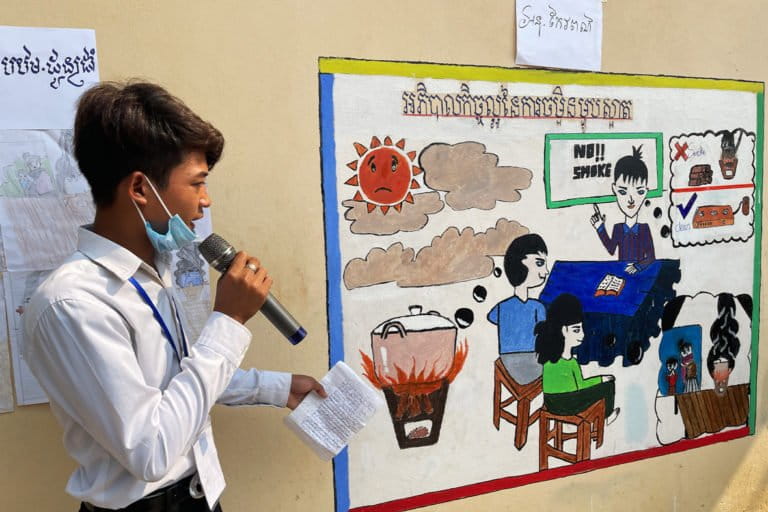
“It was the first time I realized how harmful using traditional cookstoves is to our health,” Sim said. In June, she put aside her two traditional Lao stoves and invested in an electric rice cooker and small LPG stove. “Cooking is less of a burden to me now,” she said. “It’s so much more efficient and easier, and our kitchen is also cleaner.”
Between September 2020 and March 2021, more than 1,900 clean cookstoves were bought by residents who attended educational events. SNV has pledged to continue the education program until 2024, with the goal of getting 80% of villagers in the provinces to convert from traditional stoves to clean ones. The first village is expected to be declared smoke-free by the end of 2021.
Cooking with … coconuts?
Khmer Green Charcoal (KGC) is another organization putting forward innovative solutions to reduce the 300,000 tons of charcoal consumed annually across Cambodia. Finding those solutions has never been more urgent, with both the U.N. Food and Agriculture Organization (FAO) and the U.N. Development Programme (UNDP) predicting charcoal consumption will grow until at least 2035 globally.
KGC founder Carlo Figà Talamanca is focused on finding one such alternative — especially one acceptable to Cambodians. “It’s not as if people can barbecue with electricity,” he said, noting too that cooking with charcoal is deeply ingrained as a national tradition. “People believe if they cook rice on a charcoal stove it tastes better. It’s in their culture; it’s cheap; it’s everywhere. You can’t simply get rid of it, so we wanted to develop a sustainable alternative” that can be embraced by people enthusiastically.
The award-winning company thinks it’s found precisely that perfect solution. Since 2018, it’s been producing “clean” charcoal made from waste coconut shells and waste biomass at its factory outside Phnom Penh. The result: cleaner, greener briquettes.
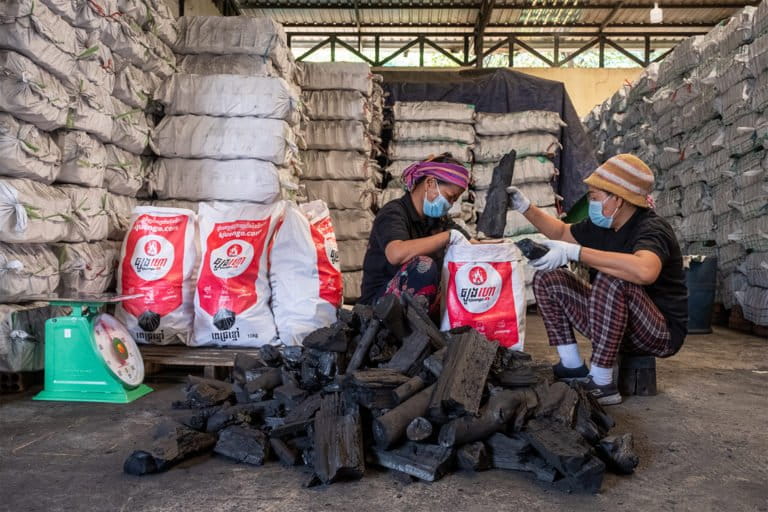

Today, KGC supplies this green charcoal to more than 6,500 households and businesses across the nation. Since starting operations, the firm says it has saved the equivalent of 400 football pitches of Cambodian forest — 1 hectare (2.5 acres) of trees every three days.
But preserving the environment isn’t always at the forefront of concerns for KGC customers, who are mostly street-food vendors and roadside restaurant owners. “It’s not enough to sell your product,” Figà Talamanca explained. “It has to be good quality. People don’t buy something worse; you have to propose something that’s at least as good or better. But the most important thing is price.”
While KGC coconut and woody waste “charbriquettes” are slightly more expensive than traditional charcoal, they have another edge. They burn longer, at about five hours, and create no sparks and significantly less smoke.
That innovation has firmly planted Cambodia on the map as a global leader within the sustainable charcoal sector, picking up a clutch of awards, including the Energy Globe National Award for Cambodia and the International Ashden Award.
More important than accolades, these coconut shell and woody waste charbriquettes have received the seal of approval from Cambodia’s true charcoal connoisseurs.
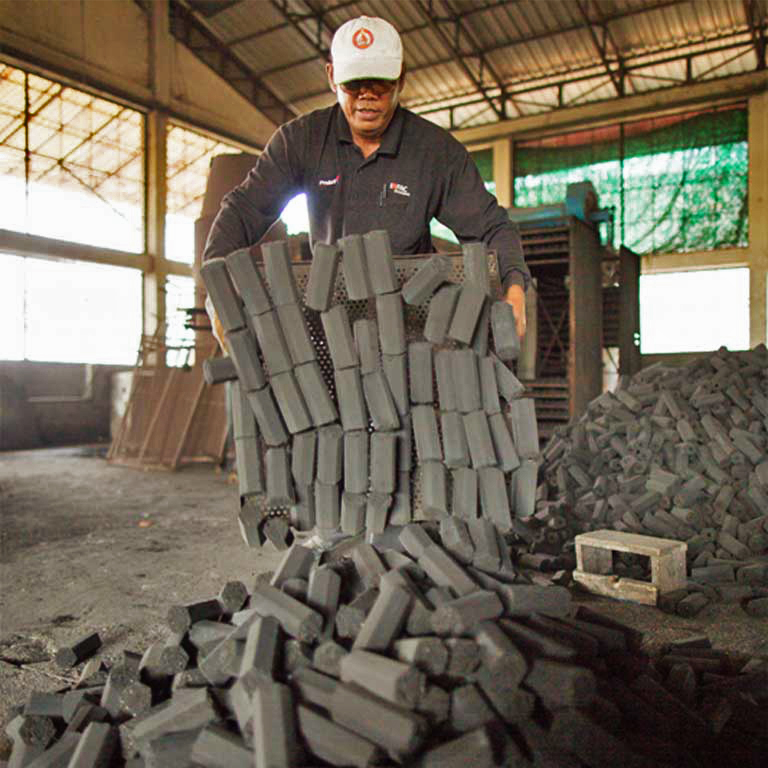
“We know our charbriquettes are good quality and the price point is right as many of our customers are professional charcoal users and they keep coming back,” Figà Talamanca said. “They only buy the stuff that’s good for their business and pocket.”
Lin Hai is a good example. She’s a Phnom Penh restaurant owner and loyal KGC customer. She prefers charbriquettes due to their making fewer hazardous sparks arising from grills, protecting customers and cooks, while reducing fire risk.
The money saved is another bonus. Hai said she only needs to use two or three charbriquettes to cook up a batch of cha trop sach chruk to perfection, a traditional Cambodian pork dish.
“I also like it because of the little smoke,” she added. “It doesn’t leave stains on my pans; my kitchen is clean and the air is fresh. Also, my food tastes good and doesn’t smell of smoke.”
There’s a downside to KCG’s extreme success. The company has so far been unable to capitalize fully on its popularity because it can’t produce enough charbriquettes to supply Cambodia’s huge charcoal market due to a lack of coconut shells. To overcome this challenge, KCG recently launched KjuonGo, which produces traditional charcoal with a smaller carbon footprint.

KjuonGo sources sustainable wood from tree plantation residues and from managed community forests, where residents are limited to an annual quota for the amount of wood they can fell and replant. KjuonGo has also digitalized the market via a mobile app that tracks the supply chain from cut wood to end user.
“We’re trying to formalize the sector,” said Figà Talamanca, who notes that cooking fuels currently lack official standards. “We have [created] a product that has had a great response from the government and consumers. The government is happy because they want to find a solution to charcoal [pollution and deforestation]. Customers like it because when we produce charcoal from wood, we use improved technology as opposed to traditional mud kilns, so it’s better quality at a competitive price.”
Another innovative scheme the company is currently rolling out in partnership with the nation’s Ministry of Agriculture, Forestry and Fisheries is a chicken-brooding project. For the first 21 days of life, a chick needs to be kept consistently warm, otherwise mortality rates can rise to 30-40%.
In Cambodia, chicken farmers burn traditional charcoal to keep poultry warm. This is now being replaced with KGC’s charbriquettes. “It’s great for farmers, as they burn longer, so [producers] don’t have to get up in the middle of the night to change the charcoal,” Figà Talamanca said.

Going global
In 2019, building on its Cambodian success, KGC formed OTAGA, a holding company based in Singapore to franchise its clean sustainable cooking model worldwide.
COVID-19 delayed business plans, but once travel resumes across Asia, OTAGO expects to set up shop in Indonesia, which has the benefit of being the world’s largest coconut producer. OTAGO also plans to expand to Kenya and work with the United Nations Human Rights Council (UNHRC) to build factories at refugee camps. (Refugees are among the top users of woody biomass for cooking, especially charcoal, worldwide.)
“One of the biggest problems is fuel. People think, we need to give food [to refugees] but how do they cook it? The problem is, if you go and start cutting wood [on] farmers’ [land] it causes tension. And [solitary] women are in danger of being assaulted when they collect wood. Instead, we will set up charbriquette factories that use agricultural waste from farmers and provide employment,” Figà Talamanca said.
KGC also expects to work with the FAO in Kiribati, a remote archipelago in the Pacific Ocean comprising 33 small islands, of which 20 are inhabited. “They have no fuel, but they have plenty of coconuts!” Figà Talamanca said.

Another solution: Biodigesters
Biodigesters, which break down organic waste feedstock in an anaerobic environment to make biomethane (also called renewable natural gas), are another tool helping Cambodian households and farms clean up their cooking and providing for energy needs. Since 2015, Cambodian biogas startup and social enterprise ATEC has positioned itself as a leader in the field, offering biodigester systems to farmers.
The technology converts animal manure and green and kitchen waste into clean methane gas for cooking, while also producing organic fertilizer as a by-product. Biodigesters help reduce greenhouse gas emissions, decrease chemical fertilizer use, and keep kitchens free of hazardous soot and wood smoke.
Since ATEC began operation, it claims that its biodigesters have made more than 552.8 million liters (146 million gallons) of biogas and 28,400 tons of organic fertilizer.
Farm families also reap financial rewards. A family of seven, utilizing waste from just three pigs or cows, can save $500 per year with the free gas an ATEC biodigester makes. That biodigester will also produce up to 20 tons of organic fertilizer each year that can increase crop yields by about 30% for vegetables and fruit, and about 12% for rice.
However, each biodigester system (including the biodigester itself, kitchen connections, a cookstove and rice cooker) initially costs $700, a potentially big financial burden for a farm family. To counter that problem, ATEC launched its Paygo program, allowing customers to pay off their investment via a monthly $30 fee over 27 months, with no required collateral.

“We’re targeting low-income households, so finance is an issue,” said country director Nikolai Schwarz. “We had to come up with a solution and the pay-as-you-go system seemed the best way. [Farmers] are saving money on buying either LPG or firewood and fertilizer, so that can be used for the monthly payments.”
Biodigesters are relatively new to Cambodia, so building initial customer trust is key for ATEC. But the organization has already surpassed its five-year goal, achieving more than 8,000 installations and reaching 12% of villages in the nation.
“Our farmers are curious and adventurous, they want to try something new,” Schwarz said. “They’re the kind of farmers who don’t want to use chemical fertilizer, as they can sell organic produce for [a higher price]. That’s now! If we want to sell to every farmer, there needs to be more education and promotion.”
To help combat sales resistance, ATEC recently launched its brand promise guarantee, allowing farmers to trial the company’s biodigester for three months. If the user fails to produce free gas and fertilizer, the unit can be returned at no cost. To date, the firm has seen a 100% customer retention rate.
ATEC has grand plans for the future. It aims to triple monthly output by mid-2022 and expand to five countries: India, Myanmar, Indonesia, Papua New Guinea and Thailand. This major growth spurt started with new operations in Bangladesh in 2020. ATEC has also expanded its clean cooking program reach. Earlier this year, it launched eCook, an induction stove (flameless cooking using magnetism) which the company is making available to farmers with access to the electric grid.
“These are more energy-efficient, cleaner, faster and safer to use than wood fire or LPG-fueled stoves, and another step towards cleaner, healthier kitchens across Cambodia,” Schwarz concluded.

Banner image: A farmer applies organic fertilizer produced by his ATEC biodigester. Image courtesy of ATEC.
FEEDBACK: Use this form to send a message to the author of this post. If you want to post a public comment, you can do that at the bottom of the page.
